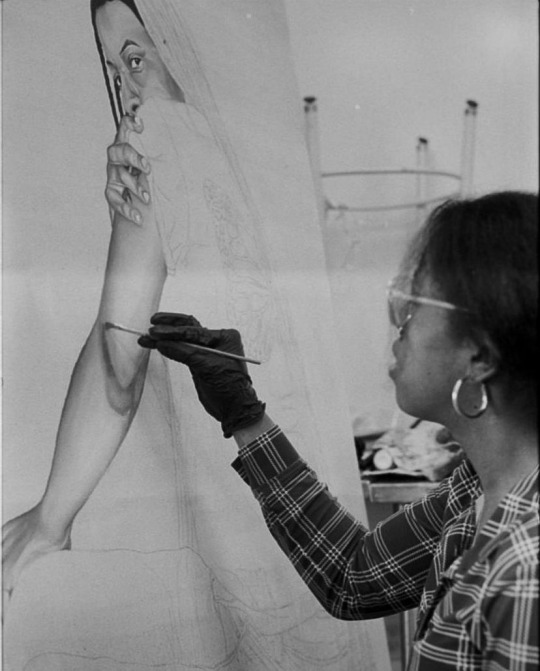#theblackarthistoryhottie
Explore tagged Tumblr posts
Text

Black and Biblical: Supper at Emmaus (c.1530-40)
Supper at Emmaus is an oil on panel painting, created by an unknown painter from 1530 to 1540 of the Italian Renaissance, and is currently on display at the Walters Art Museum located in Baltimore, Maryland. This painting depicts Jesus Christ as the central subject, in an outdoor setting, being surrounded by four men at a table as they are "breaking bread" with Christ with the nourishments present on the table. Supper at Emmaus is a visual depiction of the biblical testament of Luke 24:36-39, which describes the aftermath of Christ's resurrection as two disciples (in this case four disciples), are in the presence of the Christ who proves to them that he is a living being of flesh and bones, and not a spirit, and that they are witnesses of him being risen from the dead in order to preserve the souls of all people so they will not be condemned for their sins and the disciples must fulfill everything he has established in the Laws of Moses and the Prophet of Psalms.
The Supper at Emmaus of 1530-1540 is one of many versions, but this is the only version that features a Black/African subject being featured in religious context and in close proximity to Christ. The Black figure presented in the painting is wearing a tall red wool material hat and Black clothes which is the typical attire of an Egyptian soldier of this time. In the painting, the Egyptian soldier also passes the dish (the broiled fish) to Christ as he is breaking bread. The act of breaking bread is a communal effort of harmony and expression of affirming love, trust, and connection with one another. The Black Egyptian diaspora has an expansive influence in Italy dating back to 2nd century BC. During this time in Venice, Italy, the presence of Egyptians was significant as they came and established numerous professions for themselves such as soldiers, bankers, surgeons, actors, servants, and etc.
The Supper at Emmaus is one of the earliest artworks ever made that featured a Black subject being presented in biblical context and as an associate to Christ. A Black figure being featured in this event demonstrates the testimonial integrity that was established through the act of Jesus dying for the redemption of everyone’s souls. It also expresses how much of an influence the Egyptians have in Italy at this time, to be incorporated in such an honorable and sacred event. The incorporation of the Egyptian soldier is a reflection of the inclusion of anyone no matter what race and ethnicity, they are redeemed by God through Christ’s honor. Although no other associates were featured in Luke 24: 36-49, the inclusion of two additional figures, especially of African identity, promotes the inclusivity of Christ’s salvation that was granted to all nations and races.
#black art history#theblackarthistoryhottie#the black art history hottie#italian renaissance#painting#oil painting#analysis#art#artwork#Supper at Emmaus#Black and Biblical#art history#arthistory#oil on panel#biblical#Bible#biblical art
21 notes
·
View notes
Text

Hello to every beautiful soul that landed on my blog. My name is Alexandria, the Black Art History Hottie, who is here to express her love of educating how the Black diaspora always been present in historical context of the visual art world. I am a 24 years old painter, who graduated from the Illustrious institution, Morgan State University, with my bachelors in Fine Arts - Multimedia art (concentration in painting). The work I produce are figurative and portrait paintings, mostly self-portraitures. My vulnerability and story-telling is what guides me to my self-portraiture pieces; and for my figurative paintings I honor and celebrate culture and traditions of the Black diaspora by illuminating the historical, revolutionary, and profound act of us existing.
I've had an interest in art history since the 11th grade, but I found love and fascination of it when I was a sophomore in college. Learning how societies evolved, cultures being established, and even civilizations going into turmoil; and analyzing how that is represented in art for centuries became thrilling for me. I discovered the importance of learning historical context displayed in the visual art world is a reflection of the diverse human experiences that shaped our cultures and customs, carry traditions, and share historical events that will never go untold. After completing all of my western art history courses in college I felt as if there was something missing from my art academia , and that was the not learning about the influence of the Black diaspora in the art history world.
During college I only learned a fraction of how Black people were present in the art world during my American art class, but I knew our history is more expansive than just being secluded to American art. After college I made it my hobby to invest myself into learning not only more about art history, but how the Black diaspora is referenced and represented in art history. That is how the Black Art History Hottie was born. To allow me to use this platform to share the extensive knowledge and our rich history, culture, and customs that is reflected in art. How Black people are exemplified in the fine arts world, and we deserve to see ourselves outside the history of trauma and oppression that was meant to tear us apart. We are more than such perpetual trauma. No matter where we step foot in, we've always became apart of historical context, and such historical context should be learned, embraced, and celebrated. While passing down such knowledge from generation to generation is what establishes the value of the art history; For it to not be forgotten.
#theblackarthistoryhottie#arthistory#art#history#Black history#black diaspora#visual arts#fine arts#Black art history#African-American
12 notes
·
View notes